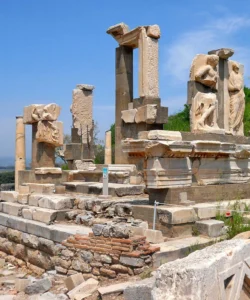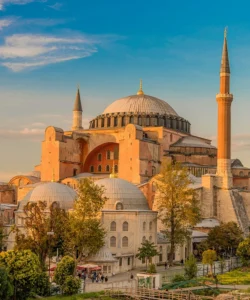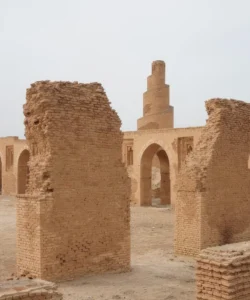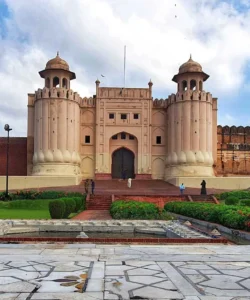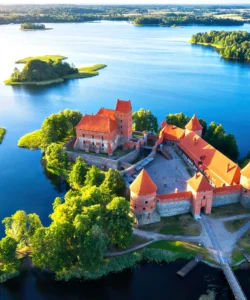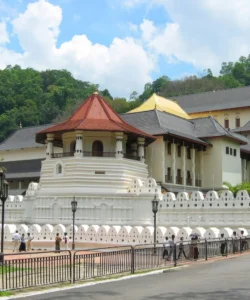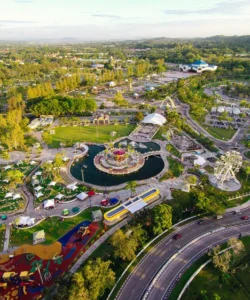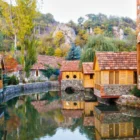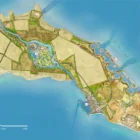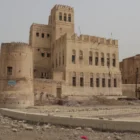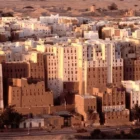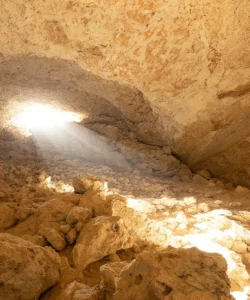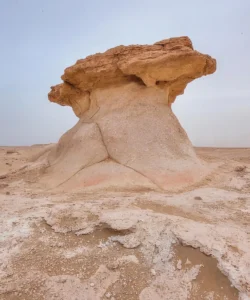Geghard Monastery (Armenian: Գեղարդի վանք, Geghardi vank) is an extraordinary medieval monastery in Armenia, partially carved out of the adjacent mountain and surrounded by towering cliffs. It’s a UNESCO World Heritage Site, celebrated for its unique rock-cut architecture and profound historical and spiritual significance.
Listen to an introduction about Geghard Monastery
Name and Address
- Name: Geghard Monastery (also known as Ayrivank (“Monastery of the Cave”) or Geghardavank (“Monastery of the Spear”)).
- Address: Kotayk Province, Armenia.
- Location: Situated approximately 40 kilometers (25 miles) east of the capital city, Yerevan, at the entrance to the picturesque Upper Azat Valley. It’s nestled amidst dramatic cliffs, with parts of the complex literally hewn from the living rock.
How to Get There
Geghard Monastery is a popular and accessible day trip from Yerevan.
- By Car/Taxi: Driving is a convenient option, taking about 40 minutes from Yerevan. Taxis and ride-sharing apps are readily available.
- By Minibus (Marshrutka): Buses (numbers 266 and 284) depart regularly from Yerevan’s Gai Bus Station (in the Nor-Nork district) to Goght village, which is near Geghard. The journey takes about 1 hour to 1 hour 10 minutes. From Goght, you might need a short taxi ride or a walk to the monastery.
- Organized Tours: Many tour operators offer combined day trips from Yerevan that include Geghard Monastery, the nearby Garni Temple, and the Symphony of Stones. This is often the most hassle-free way to visit.
- Visitor Access: Geghard Monastery is open to the public.
- Entrance Fee: There is no entrance fee to visit the monastery complex itself.
- Hours: It’s typically open daily from 9:00 AM to 6:00 PM (some sources indicate 8:00 AM to 8:00 PM). It’s always a good idea to check locally for the most current hours.
- Dress Code: As a sacred site, visitors are encouraged to dress modestly (shoulders and knees covered). Women are generally expected to cover their heads when entering the churches.
Landscape and Architecture
Geghard Monastery is a remarkable example of medieval Armenian monastic architecture, seamlessly integrated into its natural surroundings.
- Rock-Cut Architecture: A significant portion of the complex is carved directly into the solid rock of the adjacent mountain. This includes churches, chapels, tombs, and monastic cells, creating a unique and awe-inspiring appearance.
- Main Structures: The complex includes:
- Katoghike (Main Church): Built in 1215, this is the central cathedral, featuring intricate carvings, a cruciform plan, and a dome. Its southern facade is particularly ornate, with reliefs depicting a lion attacking an ox, symbolizing princely power.
- Gavit (Narthex/Entrance Hall): An impressive entrance hall attached to the main church, also featuring intricate carvings and a central aperture in its dome that allows light to filter in.
- Rock-Cut Churches and Tombs: Several churches and tombs are entirely dug into the rock, including the Avazan (Basin) rock-cut chapel (believed to be the site of a sacred spring) and the princely tombs (zhamatouns) of the Proshyan family.
- Materials and Craftsmanship: The monastery is built from finely cut lava stone, with detailed masonry and intricate carvings of animals, flora, and geometric patterns in high relief. Numerous khachkars (Armenian cross-stones) are carved into the rock faces and freestanding throughout the complex.
- Sacred Spring: The monastery was originally founded at the site of a sacred spring within a cave, and holy water still flows from one of the rock-cut cells, believed to have healing properties.
What Makes It Famous
Geghard Monastery’s fame is deeply rooted in its unique architecture, historical significance, and spiritual importance:
- UNESCO World Heritage Site: It is recognized by UNESCO for its exceptionally well-preserved medieval Armenian monastic architecture and decorative art, particularly its innovative rock-cut features.
- Monastery of the Spear: Its full name, Geghardavank, comes from the Holy Spear that allegedly pierced Christ’s side during the Crucifixion, said to have been brought to Armenia by Apostle Jude (Thaddeus) and housed at the monastery for centuries before being moved to Etchmiadzin. This relic made it a major pilgrimage site.
- Rock-Cut Marvel: The seamless integration of built structures with chambers carved directly into the cliff face is a stunning architectural achievement and its most distinctive feature.
- Spiritual and Cultural Center: Throughout the medieval period, it was not only a religious hub but also a significant educational institution, school, scriptorium, and library, contributing to Armenian manuscript art.
- Dramatic Setting: Its location amidst towering cliffs at the entrance of the Azat Valley adds to its majestic and mystical aura.
Differences from Some Other Landmarks
Geghard Monastery distinguishes itself from other landmarks in several key ways:
- Rock-Cut Integration: Unlike the classical, freestanding Garni Temple (its nearby pagan counterpart), Geghard’s fame lies in its unique fusion of built and rock-cut architecture, with many of its structures literally carved out of the mountain. This creates an immersive and organic feel.
- Christian Monastic Complex: While Garni represents Armenia’s pagan past, Geghard is a profound example of medieval Armenian Christian monasticism, showcasing a different era and religious tradition through its architecture and purpose.
- Spiritual Pilgrimage Site: Its historical association with the Holy Spear and its continuous use as a place of worship and pilgrimage give it a deep spiritual resonance that sets it apart from purely historical or architectural sites.
- Remote yet Accessible: While offering a sense of seclusion due to its cliffside setting, it remains relatively accessible from Yerevan, allowing visitors to experience a remote spiritual haven without extreme travel challenges, unlike some truly isolated monastic complexes.
Geghard Monastery Photos:
































